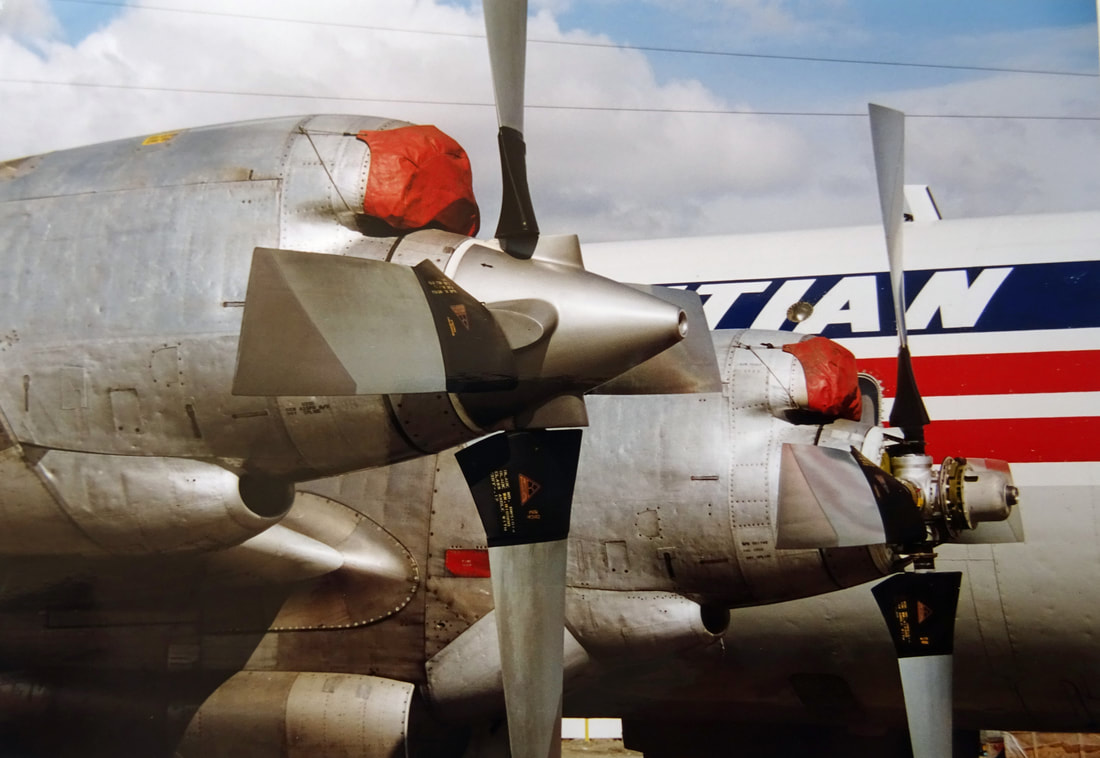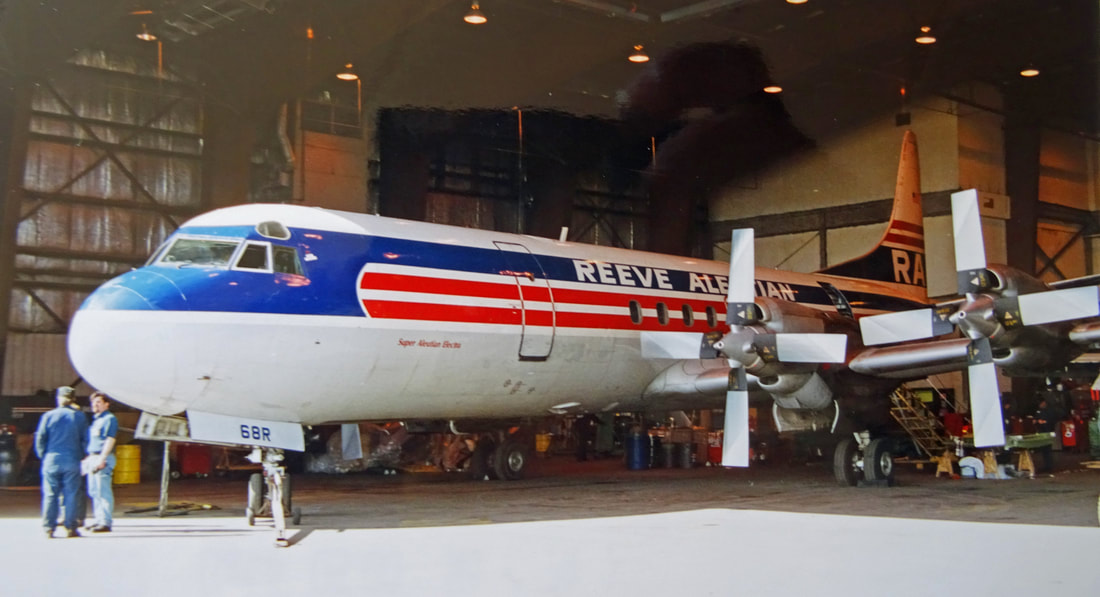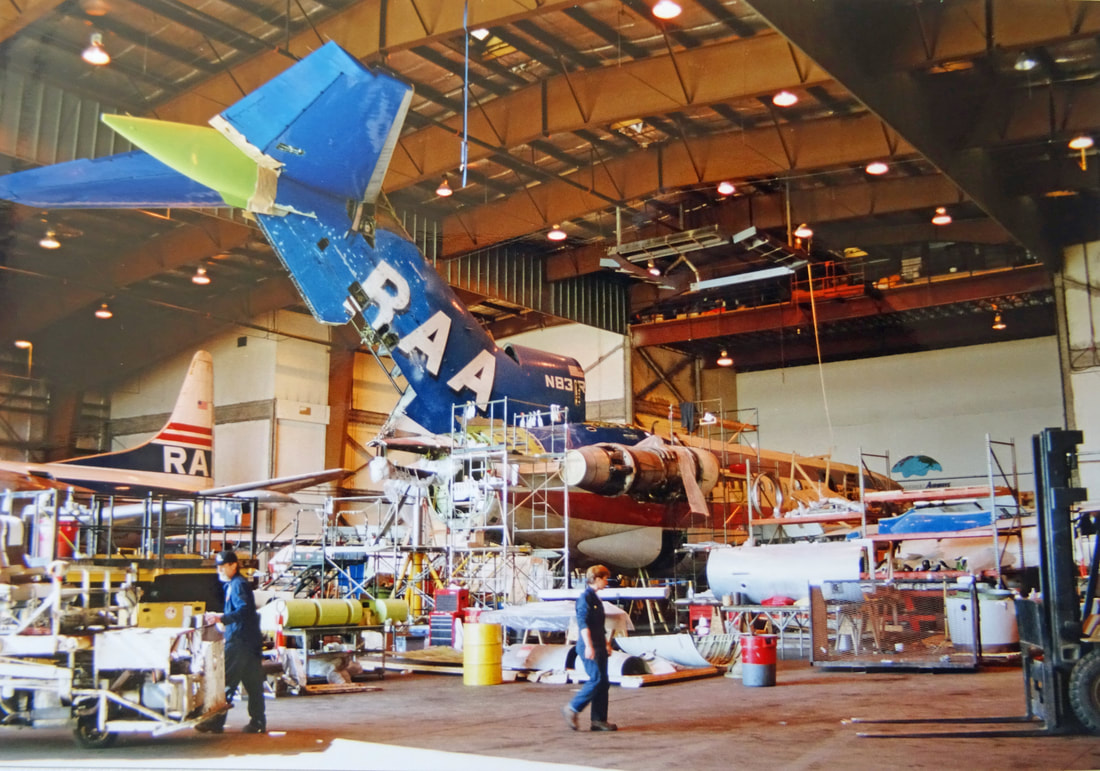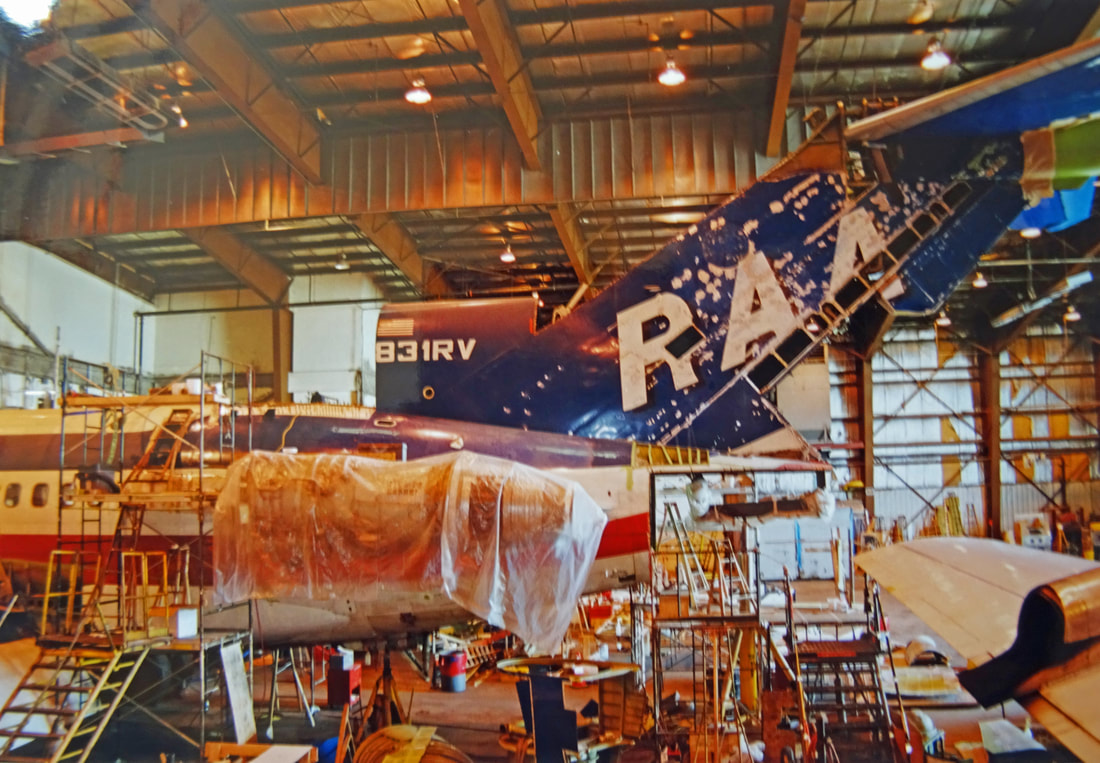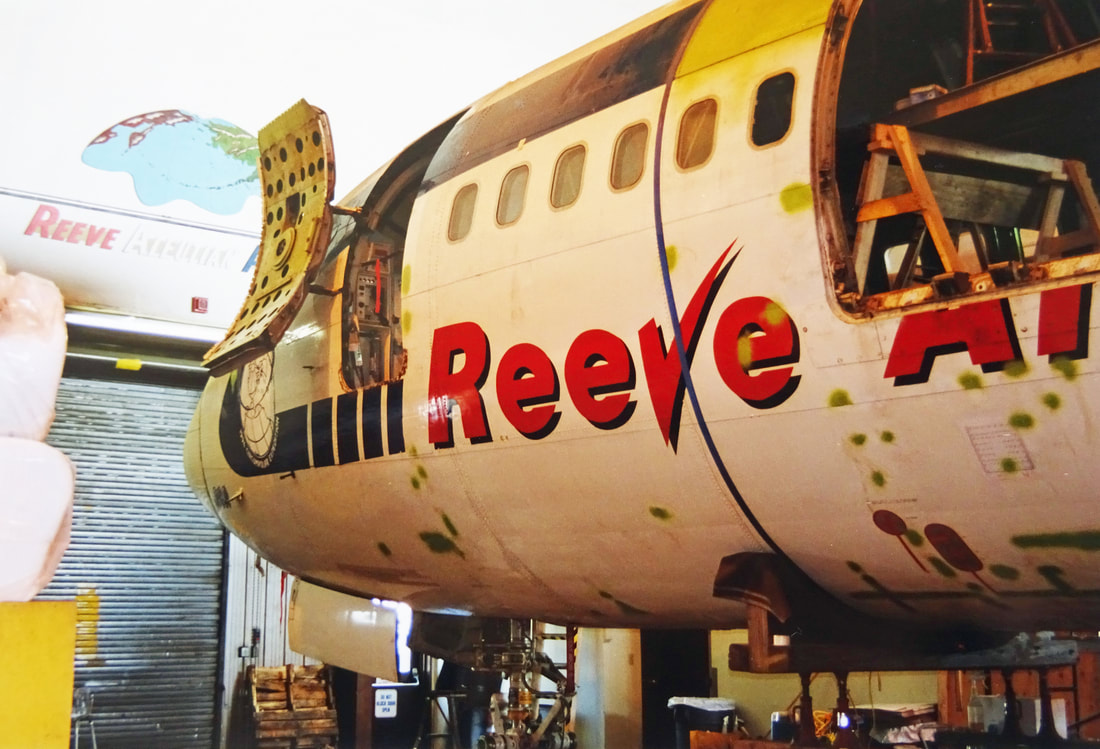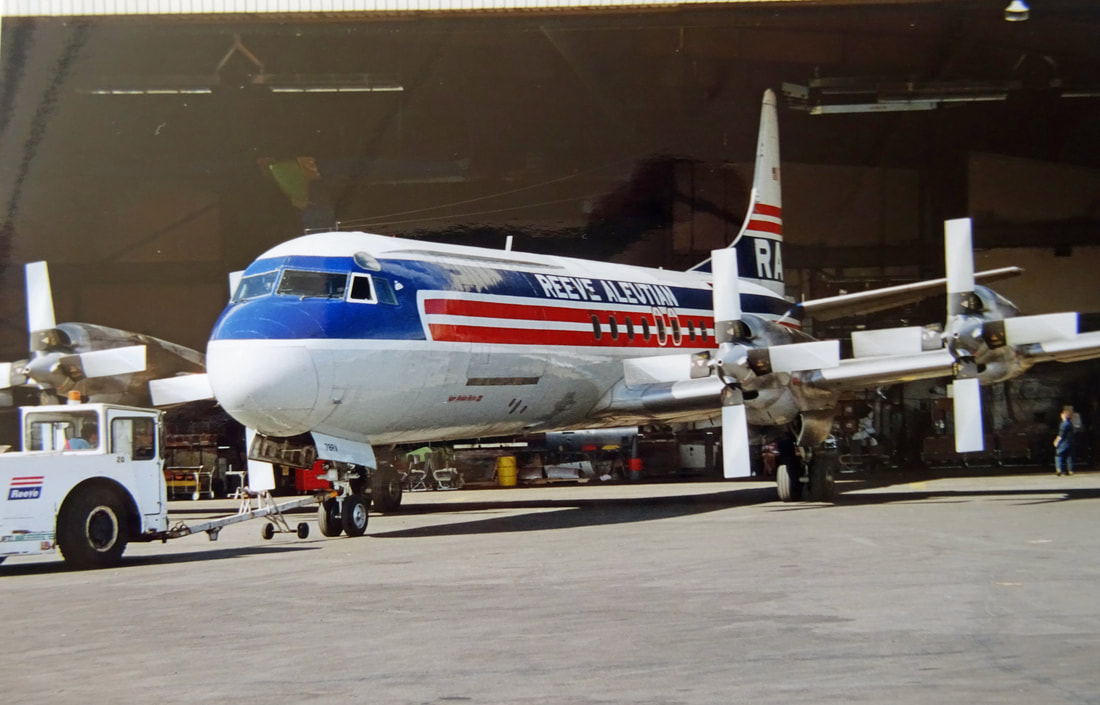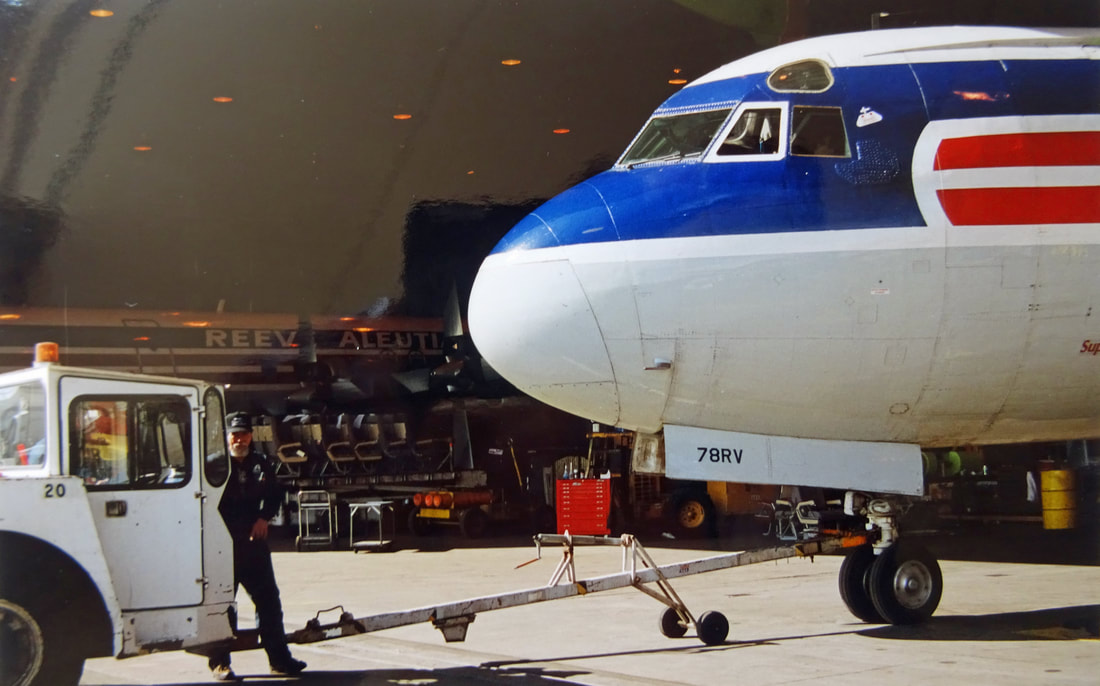Reeve Aleutian, Alaska
by Jan Koppen
When working for KLM Cargo, one is always surrounded by the modern screaming jets. Once a while, the need for some aviation nostalgia must be fulfilled. Nowadays, the choice is limited. Fortunately, Alaska is a land with still a good number of operational Big Props. In April 2000, I decided to visit this Greatland.
The pics are digital copies of paper photos, so quality low, but what does it matter? It goes about the experience!
The pics are digital copies of paper photos, so quality low, but what does it matter? It goes about the experience!
1959-built Reeve Aleutian Lockheed Electra N781RV at Anchorage being loaded for her flight to Cold Bay, Alaska, with a intermediate stop in Dutch Harbor.
Reeve Aleutian Airways was an airline headquartered in Anchorage, Alaska, United States. It ceased operations on December 5, 2000.
In February 1946, Bob Reeve received a call informing him that some ex USAAF C-47s and Douglas DC-3s were for sale (the C-47 being the military version of the DC-3). Reeve bought his first DC-3 for $20,000 with $3,000 down and the balance payable over 3 years. The cost of conversion to civilian standard was quoted at $50,000 but Reeve did the work himself at a cost of $5,000.
In April 1948, Reeve Aleutian Airways was granted a temporary, five-year airline certificate. With the need to run the business on proper business lines (maintain an office, publish schedules and tariffs etc.). In October 1948, Port Heiden was de-activated, followed by Dutch Harbor, Attu and Umnak.
In 1952, the new Anchorage International Airport opened and all the other airlines moved there. In 1953, final military deactivation of the Aleutian airfields occurred. Reeve obtained leases on Shemya and Cold Bay. Shemya closed in 1954 and all flights were switched to Cold Bay.
Expansion
By the mid-1950s, it was apparent that the DC-3's were not big enough for Reeve Aleutian. Therefore, the Douglas DC-4 was selected to supplement the DC-3s, eventually replacing them. Reeve's first DC-4 was purchased in March 1957.
In 1957, the Distant Early Warning line was being constructed, bringing a boom to Reeve Aleutian. In 1957, two Curtiss C-46 Commandos were purchased. Merrill Field proved too small for the DC-4, so Reeve Aleutian moved to Anchorage International in 1958. By the early 1960s, the DC-4 was proving outdated, and therefore a Douglas DC-6B was purchased in January 1962.
In February 1946, Bob Reeve received a call informing him that some ex USAAF C-47s and Douglas DC-3s were for sale (the C-47 being the military version of the DC-3). Reeve bought his first DC-3 for $20,000 with $3,000 down and the balance payable over 3 years. The cost of conversion to civilian standard was quoted at $50,000 but Reeve did the work himself at a cost of $5,000.
In April 1948, Reeve Aleutian Airways was granted a temporary, five-year airline certificate. With the need to run the business on proper business lines (maintain an office, publish schedules and tariffs etc.). In October 1948, Port Heiden was de-activated, followed by Dutch Harbor, Attu and Umnak.
In 1952, the new Anchorage International Airport opened and all the other airlines moved there. In 1953, final military deactivation of the Aleutian airfields occurred. Reeve obtained leases on Shemya and Cold Bay. Shemya closed in 1954 and all flights were switched to Cold Bay.
Expansion
By the mid-1950s, it was apparent that the DC-3's were not big enough for Reeve Aleutian. Therefore, the Douglas DC-4 was selected to supplement the DC-3s, eventually replacing them. Reeve's first DC-4 was purchased in March 1957.
In 1957, the Distant Early Warning line was being constructed, bringing a boom to Reeve Aleutian. In 1957, two Curtiss C-46 Commandos were purchased. Merrill Field proved too small for the DC-4, so Reeve Aleutian moved to Anchorage International in 1958. By the early 1960s, the DC-4 was proving outdated, and therefore a Douglas DC-6B was purchased in January 1962.
|
1970's
The late 1960s saw the emergence of the Lockheed L-188 Electra turboprop airliner, which was to be backbone of Reeve Aleutian's business until Boeing 727-100 jets joined the fleet in later years. The first was purchased from California Airmotive in February 1968. With the acquisition of the Electras, the DC-6s were phased out of passenger service. Reeve Aleutian still had DC-3's in service, and a replacement was sought. The NAMC YS-11A was decided on and the first aircraft was purchased new in 1972. In 1973, the Electra was certified by the CAA to land on gravel runways. On November 11, 1974, there was a hangar fire at Anchorage, and two Electra aircraft were destroyed. In 1979, Reeve Aleutian initiated nonstop service between Cold Bay, Alaska and Seattle–Tacoma flying the Lockheed L-188 Electra. |
The jet age
In December 1983, Reeve Aleutian purchased two Boeing 727-22QC combi aircraft from Wien Air Alaska. During the Christmas 1985 holiday, there was a large backlog of mail at Seattle–Tacoma and Reeve Aleutian contracted with the USPS to relieve the backlog.
The airline entered the 1990's on a relatively tight budget, with three aircraft mothballed and one leased out. In August 1999, Reeve Aleutian entered into a code-share agreement with Alaska Airlines on the route between Seattle, Anchorage and Petrovpavlosk and Yuzhno-Sakhalinsk.
End of operations
Reeve Aleutian ceased operations on December 5, 2000, and about 250 people were declared redundant. Reasons given for the situation included increased competition and high fuel prices. At the end, only one Lockheed Electra propjet and one Boeing 727 jetliner were in service.
In December 1983, Reeve Aleutian purchased two Boeing 727-22QC combi aircraft from Wien Air Alaska. During the Christmas 1985 holiday, there was a large backlog of mail at Seattle–Tacoma and Reeve Aleutian contracted with the USPS to relieve the backlog.
The airline entered the 1990's on a relatively tight budget, with three aircraft mothballed and one leased out. In August 1999, Reeve Aleutian entered into a code-share agreement with Alaska Airlines on the route between Seattle, Anchorage and Petrovpavlosk and Yuzhno-Sakhalinsk.
End of operations
Reeve Aleutian ceased operations on December 5, 2000, and about 250 people were declared redundant. Reasons given for the situation included increased competition and high fuel prices. At the end, only one Lockheed Electra propjet and one Boeing 727 jetliner were in service.
I always like a nice crisp morning to start a ramp tour.
This Lockheed L-188C rolled-off the Burbank production-line in early 1961. The aircraft was ordered by Western Airlines and registrated N9744C. She spent nine years with Western, in which she crisscrossed between the many US states. In September 1970 Western sold her to Reeve Aleutian. An impressive 32 years later she left Alaska for the UK and Atlantic Airlines became the new owner who registrated her G-FIJV. After several years of storage at Coventry she was made flyable again and ferried in June 2011, to her new owner Buffalo Airways, who placed her in storage at Red Deer, Alberta, Canada.
Lockheed Electra-A N9744C on the ramp at ANC, April 30, 2000.
N9744C Allisons, full of dents and scratches.
What a beautiful paint job.
As mentioned before, after her long service with Reeve N9744C left for the UK to work with Atlantic. After a long storage at Coventry she was made airworthy again and airtested on June 26, 2011. Two days later she made the Atlantic crossing on her way to Red Deer, Canada.
N9744C's hail wear tear radome.
Combi configured Lockheed Electra N1968R was front-line equipment with Reeve Aleutian Airways for many years.
Electra N1968R. The aircraft first flew in November 17, 1959 as VH-ECC and was accepted by Qantas several days later. This airframe enjoyed a long and various career. Next to Qantas, she operated respectively for; - Air New Zealand, California Airmotive Corporation, Reeve Aleutioan before being sold to Air Spray as Tanker C-GHZI.
Reeve Aleutian Lockheed Electra N1968R is pushed back in the company's hangar at Anchorage airport.
Reeve Aleutian Airways Flight 8 was an American domestic flight from Cold Bay, Alaska to Seattle, Washington on June 8, 1983. Shortly after taking off, the Lockheed L-188 Electra of Reeve Aleutian Airways was travelling over the Pacific Ocean when one of the propellers broke away from its engine and struck the fuselage, damaging the flight controls. The pilots were able to make a successful emergency landing at Anchorage International Airport; none of the fifteen passengers and crew on board were injured in the incident.
The aircraft involved in the incident was a Lockheed L-188C Electra, powered by 4 turboprop engines, with manufacturer's serial number 2007 and registration N1968R. It had been delivered to Qantas in 1959. In 1968, after service with other airlines, including Air New Zealand and the California Airmotive Corporation, the aircraft was sold to Reeve Aleutian. It had flown approximately 33,000 hours in service at the time the accident happened.
Just after takeoff from Cold Bay Airport, on the Alaska Peninsula for a flight across the northern Pacific Ocean to Seattle, Washington, with 10 passengers, the crew noted an unusual vibration in the aircraft, but were unable to isolate the source. As the aircraft climbed from FL190 (approximately 19,000 feet (5,800 m)) to FL250 (approximately 25,000 feet (7,600 m)), the Flight Engineer left the cockpit to visually check the engines from the passenger cabin, but saw nothing amiss. The Flight Attendant went into the cockpit to discuss the vibration, which suddenly increased in intensity as she went back into the cabin. She looked out the window just in time to see the propeller on the No. 4 engine (the outboard engine on the right wing) detach itself and fly spinning under the fuselage. The propeller tore a gash 8 feet (2.4 m) long in the aircraft's belly, depressurizing the cabin and jamming the flight and engine controls.[4][5] The pilots managed to gain some control of the aircraft by using the autopilot and diverted the aircraft to Anchorage. With the engine throttle controls jammed at cruise power, on approach to land the crew was able to make the aircraft descend and climb after shutting down No. 2 (the left inboard) engine in combination with lowering and raising the landing gear.
The Electra landed safely at Anchorage International Airport, even with the loss of almost all flight controls. The crew had to shut down all engines once the aircraft was on the ground in order to help bring it to a stop; one tire blew out and the brakes caught fire.[5] Nobody was hurt when the propeller hit the fuselage or during the emergency landing. The captain, 54-year-old James (Jim) Gibson, with 5,700 hours' experience flying Electras, was honored for the successful landing by a meeting with President Ronald Reagan in the White House.[3][7] The Air Line Pilots Association also honored Captain Gibson, 39-year-old First Officer Gary Lintner and 45-year-old Flight Engineer Gerald "Moose" Laurin later in 1983 with its Superior Airmanship Award.
As the propeller fell into the Pacific Ocean and was never recovered for examination, the reason for its separation is unknown. Following the accident, the aircraft was repaired and returned to service. N1968R was de-registered in 2001 and was exported to Canada as C-GHZI, where it was used as a firefighting craft. The airline managed to continue flight operations after the accident but then began to succumb to financial issues in the early 1990s. Reeve Aleutian Airways eventually ceased operations on December 5, 2000.
The aircraft involved in the incident was a Lockheed L-188C Electra, powered by 4 turboprop engines, with manufacturer's serial number 2007 and registration N1968R. It had been delivered to Qantas in 1959. In 1968, after service with other airlines, including Air New Zealand and the California Airmotive Corporation, the aircraft was sold to Reeve Aleutian. It had flown approximately 33,000 hours in service at the time the accident happened.
Just after takeoff from Cold Bay Airport, on the Alaska Peninsula for a flight across the northern Pacific Ocean to Seattle, Washington, with 10 passengers, the crew noted an unusual vibration in the aircraft, but were unable to isolate the source. As the aircraft climbed from FL190 (approximately 19,000 feet (5,800 m)) to FL250 (approximately 25,000 feet (7,600 m)), the Flight Engineer left the cockpit to visually check the engines from the passenger cabin, but saw nothing amiss. The Flight Attendant went into the cockpit to discuss the vibration, which suddenly increased in intensity as she went back into the cabin. She looked out the window just in time to see the propeller on the No. 4 engine (the outboard engine on the right wing) detach itself and fly spinning under the fuselage. The propeller tore a gash 8 feet (2.4 m) long in the aircraft's belly, depressurizing the cabin and jamming the flight and engine controls.[4][5] The pilots managed to gain some control of the aircraft by using the autopilot and diverted the aircraft to Anchorage. With the engine throttle controls jammed at cruise power, on approach to land the crew was able to make the aircraft descend and climb after shutting down No. 2 (the left inboard) engine in combination with lowering and raising the landing gear.
The Electra landed safely at Anchorage International Airport, even with the loss of almost all flight controls. The crew had to shut down all engines once the aircraft was on the ground in order to help bring it to a stop; one tire blew out and the brakes caught fire.[5] Nobody was hurt when the propeller hit the fuselage or during the emergency landing. The captain, 54-year-old James (Jim) Gibson, with 5,700 hours' experience flying Electras, was honored for the successful landing by a meeting with President Ronald Reagan in the White House.[3][7] The Air Line Pilots Association also honored Captain Gibson, 39-year-old First Officer Gary Lintner and 45-year-old Flight Engineer Gerald "Moose" Laurin later in 1983 with its Superior Airmanship Award.
As the propeller fell into the Pacific Ocean and was never recovered for examination, the reason for its separation is unknown. Following the accident, the aircraft was repaired and returned to service. N1968R was de-registered in 2001 and was exported to Canada as C-GHZI, where it was used as a firefighting craft. The airline managed to continue flight operations after the accident but then began to succumb to financial issues in the early 1990s. Reeve Aleutian Airways eventually ceased operations on December 5, 2000.
Blades with rectangular tips are more efficient because have more blade area. That's why, the rectangular blade tips or rectangular blades are more noisy.
Inside the Reeve hangar.
This stunning photograph help capture the essence of the lost age of the early turboprops airliners.
The Allison T56 is a single shaft, modular design military turboprop with a 14-stage axial flow compressor driven by a four-stage turbine. It was originally developed by the Allison Engine Company for the Lockheed C-130 transport entering production in 1954. The commercial version is designated 501-D. With an unusually long and numerous production run, over 18,000 engines have been produced since 1954.
Interior shot of N1968R. She was the last schedule pax carrying Electra. Reeve ceased on December 06, 2000.
Her switches and controls, worn smooth by the touch of a thousand hands.
N831RV Boeing 727-22C Reeve Aleutian, at undergoing a D-check at ANC during April/May 2000. This airfrace was ex United Airlines N7405U. Later with Wien Air Alaska as N498WC and then a whole bunch of odds & ends after that until scrapped at Jo'burg several years ago.
In the Reeve hangar, well-used veteran N831RV receives its D-check.
Fatigue and corrosion problems are constant enemies of classic jetliners.
|
Founded by Belgian polar explorer Alain Hubert, Prof. Hugo Decleir and Prof. André Berger in 2002, the Brussels-based International Polar Foundation provides a novel interface between science and society, and was recognised by Belgian Royal Statute as a foundation for the public good in 2002. HM King Philippe is the International Polar Foundation's honorary president.
The Foundation seeks to bring about a keener appreciation of the role of science, particularly research in the Polar Regions, through a re-examination of the planet’s interconnections, its fragility, the impact of human actions on the environment, and the evolution of millennial climate cycles. To achieve its aims, the Foundation has initiated several high-profile projects; this includes supporting polar science through the creation and operation of the wind-and-solar-powered zero emission Princess Elisabeth Antarctica station, logistical support of scientists working in Antarctica, fellowship awards for Antarctic researchers, an annual symposium on Arctic issues, and several science and education websites and classroom activities and resources. |
This Electra flew with Tasman Empire Airways and Air New Zealand from December 1959 until the early 70's when it was withdrawn from use. The airplane had an extensive career with later owners like Reeve Aleutian, but finally found a new home with Buffalo Airways from Yellowknife, Canada.
Lockheed Electra-C N178RV is presently working for Buffalo Airways from Yellowknife as a Air Tanker C-FIJX.
I told you, governor spinner, 4 blades and rectangular blade tips. It's a Lockheed Electra.
BrutE is pushing N178RV in a corner of the Reeve hangar.
N178RV is a Super Aleutian Electra III.
Halcyon days. Eight months later Reeve Aleutian ceased operations.
They were built to fly and they showed it.
The propeller has lift on one side and drag at the other. At the tip "induced drag" is created, which means that lift and drag meet and balance out. This create tip vortices, which are accountable for most noise. When compared, rounded tips create less induced drag than square tips and thus less noise.
Unfortunely Reeve ceased scheduled services in December 2000.
- The End -




